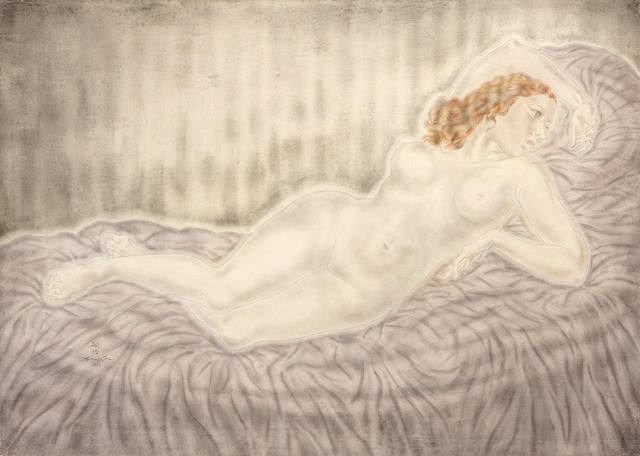
Foujita (1886-1968) is an artist I have come to appreciate more and more over time; not just his depiction of cats and nudes, but also his courage in moving to Paris in the early 20th century, battling against prejudice, creating a glittering persona for himself combined with discipline and hard work. One should keep in mind that despite his bohemian appearance, he never drank alcohol, kept meticulously clean (unlike his friend Modigliani who kept excrement under his bed and Soutine who had never used a toothbrush) and worked constantly at painting (enough for his second wife to get bored and divorce him). However, there appears to be a big mystery over his white pigment: what was it that he used? How did he make it so brilliantly white? Scholars and art critics have puzzled over this mystery. I will offer my opinion as to what I think he used, although I confess I have no scientific or historical evidence for saying so...Could it be that he used gofun? Crushed shells used in traditional Japanese painting?

Foujita's artistic achievement can be best appreciated if you view his works in a room filled with the colourful oil paintings of his contemporaries. If you are lucky enough to go to an auction house, you might perhaps see Foujita's work among Picasso's loudly dressed harlequins, the deep red and blue of a Modigliani portrait, and a bloody beef carcass by Soutine. Beside these blasts of colour, Foujita's stark paintings stand out as acts of courage. For his nudes, still lifes, self-portraits, depended upon large swaths of white, created with his special paint, and upon this surface, he often added colour in thin washes and his very fine, supple lines in the black that looked like Japanese sumi ink.

Foujita started off with the milky white ground he had perfected after much experimentation. The development of this white required artistry and cunning, as well as the patience to nurture a complex brew. In the annals of art history few buckets of white paint have caused such a fuss. Foujita's white, spread first across the canvas, can often be seen gleaming through the colours added later, but is more emphatically in the nudes, sheets, and walls, among various other white expanses in his paintings. Foujita refused to disclose the white mixture's ingredients, in order to keep the imitators at bay, and this spawned countless investigations. Recent analyses have again tried to solve the mystery by isolating such components as animal glue, lead white, calcium carbonate, and talc.

Shells are made of calcium carbonate, in the mineral form of calcite or aragonite. So it seems very probable to me that he incorporated gofun.

Gofun (胡粉 literally 'barbarian powder') is an opaque white pigment made from pulverized high quality oyster shells. It has a pearl like lustre. Used in Nihonga painting, in traditional Japanese doll making, and also often splashed on a print to imitate effects such as snow in a three dimensional manner. It is made from natural clam shell, by allowing oyster shells to decompose until all organic matter is gone then grinding the remaining shell. In traditional Japanese painting it is bound with animal glue, though theoretically it could also be bound with linseed oil to make it closer to oil paint. The recent analysis isolating the component of animal glue however, would suggest that Foujita stuck to traditional methods for using gofun.
When gofun dries, it appears smooth and lustrous. Furthermore, sumi ink or any pigment can be painted above it. It can be applied thickly like a paste to create raised sections. If Foujita used sumi ink for his lines, it is likely that the white emulsion he used was the same gofun used in Japanese painting. I have not experimented myself, but I suspect oil paints can also sit on top of the gofun once dry.
This would need to be researched further, but I hope this would be a step in the right direction in understanding the mystery behind Foujita's white pigment.

Comments